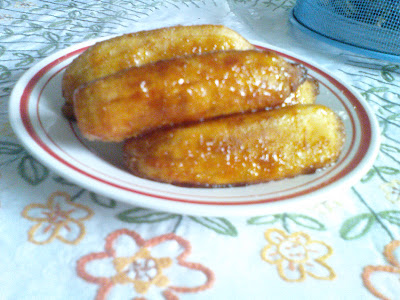
This was one of our (me teaching my boys and two nieces) cooking projects last summer. It's pretty, easy to do, yummy, inexpensive, and the choosing of colors for the galapong makes it more interesting for kids. (Although I had to hold off requests for blue and fuschia palitaw. Hehe.)
Besides, Filipino snacks are becoming a rare species, quickly being replaced by foreign, fastfood items like french fries, pizza and waffles. I felt sad when my two sons and two nieces asked "Ano yung Palitaw?" when as children my brother and I excitedly waited for the manlalako each afternoon, excited to see which among our favorites Palitaw, Buchi, Lumpia, Cuchinta, Banana Cue, Puto, Calamay were there for the taking in his magic bilao. We had enjoyable summers putting out stands in front of our house, selling Sago't Gulaman, Kalingking, Turon and Ginataan.
So it was a MUST that I taught the kids some Filipino snacks!
BTW, Palitaw is so named because of the way each piece floats and appears (litaw) from the bottom of the pan during cooking.
Nowadays you don't need to soak glutinous rice and then bring it for grinding at the local market just to make galapong. Coconut vendors at local markets usually also sell galapong in P20.00 packs (which makes about a dozen Palitaws). Mine I bought from the vegetables section of South Supermarket, priced by weight.
PALITAW
What's In It?
- 250g. Galapong
- various food coloring (optional)
- 5 cups tap water
- 1 coconut, meat shredded
- 1/3 cup white sugar
- 5-6 teaspoons sesame seeds
Kitchen Conjugations:
Toast sesame seeds in a pan over medium heat for about 2 minutes or until brown. Mix with the sugar and set aside.
Boil water in a wok or deep pan.
Meantime, if you're coloring the galapong, divide it into as many colors as you want. To each ball of galapong, pour 2-3 drops of food color (depending on how dark you want the shade to be) and work in and distribute the food color by mashing and stretching the galapong until the color is distributed.
Then cut away a small portion of the galapong (about the size of a large marble), roll into a ball then flatten into a disc. (You could have it round or oval. ) Repeat for the rest of the galapong.
Drop the flattened discs into the boiling water. Wait a few minutes for the palitaw to float to the surface of the water, then remove from the pan using a slotted spoon, onto the shredded coconut meat.
Roll / turn over the palitaw to coat both sides with the shredded coco meat. Sprinkle/top with the sugar-sesame seed mixture and serve.




 How do you eat your Ginatan? Do you, like me, start with hurriedly eating the gabi/kamoteng kahoy, then poking at the kamote, before moving on to the langka, the sago, bilo-bilo, and then finally the saba?
How do you eat your Ginatan? Do you, like me, start with hurriedly eating the gabi/kamoteng kahoy, then poking at the kamote, before moving on to the langka, the sago, bilo-bilo, and then finally the saba?